Archive:Agricultural income per annual work unit (AWU) - Indicator A
This Statistics Explained article is outdated and has been archived - for recent articles on Agriculture see here. Data from June 2014. Most recent data: Further Eurostat information, Main tables and Database.
Authors: Garry Mahon, Ruben Garcia Nuevo, Annabelle Jansen
This article presents recent statistics on agricultural income per annual work unit (AWU) (Indicator A) in the European Union (EU) and EFTA countries. According to the second estimates of the economic accounts for agriculture (EAA) submitted to Eurostat by the Member States at the end of January 2014, agricultural income per annual work unit (Indicator A) at the EU-28 level fell in 2013 by 1.3 % compared with 2012 (see Figures 1 and 2).
In 2013, agricultural labour input decreased in the EU-28 compared with the previous year (-1.2 %).


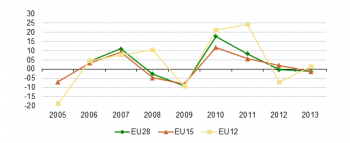


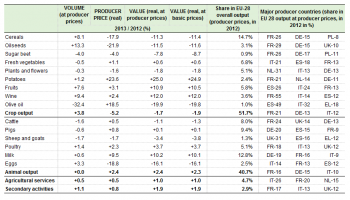
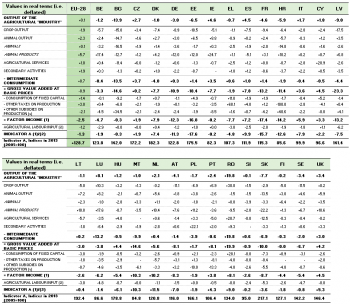
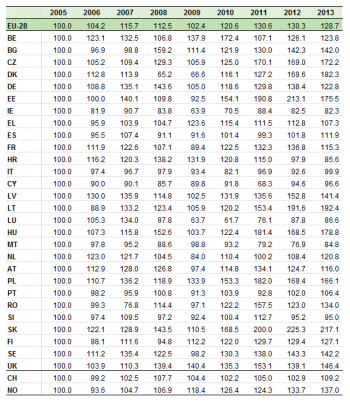
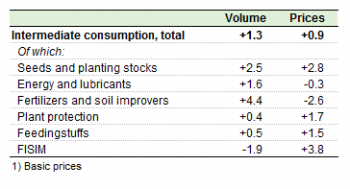
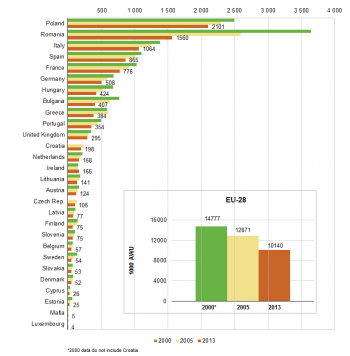
Main statistical findings
The reduction of agricultural income per annual work unit in 2013 (-1.3 %) followed a slight decrease of 0.2 % in 2012 and an increase of 8.3 % in 2011 at the EU-28 level (see Figure 3).
This latest development was driven by a decrease of 1.3 % in agricultural income per work unit in EU-15. For EU-12, i.e. those Member States which joined the EU in 2004 and 2007, showed an increase in agricultural income per work unit (+1.4 %). Finally, the agricultural labour input revealed a steeper decrease in the EU-15 (-1.8 %) than in the EU-12 (-0.6 %). For Croatia, the decrease in the agricultural labour input was 1.9 %.
On the other hand, the factor income in EU-15 decreased by 3.1 % in 2013 compared with the previous year, which, when related to the trend of agricultural labour input, resulted in a final decrease in Indicator A (-1.3 %). For EU-28, the index (2005=100) of Indicator A reached 128.65 in 2013 (see Figure 4).
This increase since 2005 is explained by both the positive developments in EU-15 and Member States which joined the EU in 2004 and 2007, which registered rises of 17.7 % and 60.3 % respectively, when compared with 2005.
Agricultural income per work unit, Indicator A, in 2013: comparison across countries
The change in agricultural income per work unit differed across the Member States of the EU-28. In 2013, the largest increases were seen in the Netherlands (+11.5 %), Malta (+10.3 %), Spain (+9.9 %), Romania (+9.0 %), and Italy (+7.9 %).
On the other hand, sixteen Member States showed a decrease in income: the steepest were seen in Estonia (-17.6 %), France (-15.7 %) and Croatia (-12.6 %). Austria, Latvia and Germany also showed marked decreases (between -7.0 % and -11.3 %).
In 2013, about 81 % of total factor income in EU-28 was generated in EU-15, by 48 % of the total agricultural labour input (in AWU). Indicator A in the three EFTA countries grew in 2013 compared with 2012. The largest increase was in Iceland (+8.5 %), followed by Switzerland (+6.1 %) and Norway (+2.4 %).
Main factors in income development for 2013
Indicator A combines the trend in the net value added at factor cost (factor income) and the trend in agricultural labour input. In EU-28, there was a decrease (-2.5 %) in factor income for 2013 compared with 2012 in real terms (which represents a decrease of 1.2 % in nominal terms), while agricultural labour input also decreased 1.2 %. Factor income development in 2013 was driven by a decrease in the output values of crop production (-1.9 %) and an increase in the value of animal production (+2.3 %).
Both, the output value of agricultural services (+1.0 %) and the output value of inseparable non-agricultural secondary activities (+1.9 %) increased in 2013 compared with 2012. Even though the overall output of the agriculture industry grew slightly by 0.1 %, according to the second estimates, this was counterbalanced by a bigger increase of 0.7 % in the value of intermediate consumption. The changes in other items led to a decrease in factor income by 2.5 %. Fixed capital consumption increased by 1.4 % while other subsidies on production fell by 2.1 % compared to 2012 (Figure 5).
The increase in the value of total agricultural output in basic prices (+0.1 %) is almost entirely due to output volume which grew by 2.0 % while prices decreased by 1.9 %. For intermediate consumption, the increase in value (+0.7 %) was due to a combination of lower prices (-0.6 %) and higher volume (+1.3 %).
Combining the developments in output and intermediate consumption, the gross value added in agriculture in 2013 at basic price fell by (-0.9 %). The level of the gross value added is slightly greater than 39 % of the output value at the level of EU-28. Overall, subsidies were around 56 billion Euro, which represents 38.5 % of the factor income.
A closer look at output
The value of the output of agricultural goods at basic prices remained unchanged in 2013 compared with 2012. This result was driven by an increase in volume (+2.1 %) counterbalanced by a decrease in the output prices (-2.1 %) of agricultural goods.
The value of crop output at basic prices went down by 1.9 %. On the other hand, animal output showed a rise of 2.3 %. Agricultural services increased slightly (+1.0 %) while the steepest increase was registered for secondary activities (+1.9 %) (see Table 1).
Crop output
The value of crop output at basic prices decreased in 2013 (-1.9 %), This result for the crop output was a combination of an increase in volume (+3.8 %) and the decrease in producer prices (-5.2 %). The trends in prices is quite different for main agricultural crops. The largest price increases in 2013 were observed for potatoes (+23.6 %), olive oil (+18.5 %) and to a lesser extent fruits (+3.1 %) and wine (+2.4 %).
Large decreases in the producer price were observed for oil seeds (-21.9 %) and cereals (-17.9 %) in 2013 compared with 2012. On the other hand, the changes in volume were negative for olive oil (-32.4 %), sugar beet (-4.0 %) and fresh vegetables (-0.5 %). The volume rose for oil seeds (+13.3 %), wine (+9.4 %) cereals (+8.1 %) and fruits (+7.6 %).
Seventeen Member States reported declines in total crop output in 2013 (see Table 2), which were most marked in Estonia (-18.5 %), Latvia (-17.5 %), Bulgaria (-15.0 %) and Sweden (-11.5 %). The largest increases in the value of crop output were observed in Romania (+30.8 %), Luxembourg (+10.3 %), Spain (+7.5 %) and Portugal (+6.9 %). The value of crop output at basic prices in EU-15 decreased by 3.1 % in 2013, while in EU-12, it increased (+4.0 %). Basic prices in real terms declined 5.4 % in EU-28, as a result of both the decreases of 4.5 % in EU-15 and 9.1 % in EU-12. Steepest decreases were recorded in Croatia (-12.5 %).
Animal output
The rise in the value of animal output recorded in 2013 (+2.3 %) was mainly due to higher producer prices (+2.4 %) while the volume of animal output remained stable in 2013 compared with 2012. At the EU-28 level, prices rose for almost all the groups included in animal output. For animal products, the value of milk increased (+10.2 %) due to the increase in both the price of milk (+9.5 %) and the volume (+0.6 %) compared with 2012. As regards egg production, the large decline in the producer price (-18.8 %) brought about a decrease of 16.1 % in value when compared with the previous year.
For animals (meat and livestock,) the value in basic prices remained stable (+0.1 %). Higher producer prices were recorded for poultry (+2.3 %), pigs (+0.8 %) and cattle (+0.5 %). On the other hand, the prices of both equines (-1.8 %) and sheep and goats (-1.7 %) declined. As regards volume, sheep and goats (-1.7 %); cattle (-1.6 %) and pigs (-0.6 %) showed a fall compared with 2012. As presented in Table 2, as many as 19 out of the 28 EU Member States reported higher values for animal output in 2013 than in 2012, with the most clear increases seen in Ireland (+8.8 %), Luxembourg (+8.2 %), Lithuania (+7.2 %) and Estonia (+6.5 %). Significant decreased values in real terms were recorded in Bulgaria (-14.7 %) and Slovakia (-13.5 %).
A medium-term analysis (2005-2013)
In order to place the most recent income developments in a medium-term perspective, Indicator A is expressed in index form, with 2005 as reference year (Table 3). According to the trend of Indicator A, Member States can be divided into two groups.
The first group includes those countries for which agricultural income in 2013 was higher than in 2005. This group comprises twenty-one Member States. In sixteen of these, the level of agricultural income per work unit reached in 2013 was more than 20 index points higher than in 2005. The most marked increases were reported by Slovakia (+117.1 %), Lithuania (+92.4 %) and Denmark (+82.3 %).
The second group comprises seven Member States which had a negative trend for Indicator A in 2013 compared with 2005: Italy, Cyprus, Slovenia, Luxembourg, Croatia, Malta and Ireland.
Increasing intermediate consumption (+0.7 %) and decreasing labour input (-1.2 %)
Value of intermediate consumption was slightly higher in 2013 than 2012
The value of intermediate consumption in 2013 rose by 0.7 % in real terms in the EU as a whole, due to a combination of higher prices (+0.9 %) and increase in volume (+1.3 %). The higher value of groups of seeds and planting stocks (+3.7 %), maintenance of materials (+2.2 %), plant protection products (+0.7 %) and feedingstuffs (+0.6 %) is offset by the decline for energy and lubricants (-0.2 %) and veterinary expenses (-0.1 %).
The volume of inputs used was up +3.9 % in the EU-12 and +1.3 % in the EU as a whole. There was an estimated 4.4 % increase in the volume of fertilisers and soil improvers used in the EU-28, with seeds and planting stocks as a group up +2.5 % and energy and lubricant volumes increasing +1.6 %. This was in contrast to decreases in the volume of FISIM (-1.9 %) and maintenance of buildings (-1.6 %).
Higher prices were recorded in FISIM (+3.8 %), maintenance of buildings (+3.1 %) and seeds and planting stocks (+2.8 %). On the other hand, prices were lower for the group of fertilisers and soil improvers (-2.6 %) and for energy and lubricants (-0.3 %).
The value of intermediate consumption rose in thirteen EU Member States in 2013, compared with the previous year. The most marked increases were seen in Romania (+19.8 %), Luxembourg (+13.2 %) and Czech Republic (+3.7 %). Out of the fifteen countries which reported a decrease in 2013, the steepest declines were observed in Bulgaria (-13.5 %), Malta (-9.9 %) and Slovakia (-6.9 %).
In real terms, energy prices decreased by 1.8 % in the EU-28 in 2013 compared with 2012. Across Member States, the overall situation varied widely among the EU-28 ranging from +6.1 % in Austria to -15.9 % in Slovakia. As regards the prices of fertilisers and soil improvers, the figures for Romania, Luxembourg, Denmark and the United Kingdom were down by more than 10 %.
Agricultural Labour Input decreased 1.2 % in 2013
In 2013, the agricultural labour input decreased slightly in twenty Member States compared with the previous year; it remained almost stable in five countries and only increased in three (Figure 6). The steepest declines were seen in Latvia (-6.2 %), Slovakia (-5.3 %), Luxembourg (-4.8 %) and Sweden (-4.7 %).
For EU-28, agricultural labour input in 2013 is down by 1.2 % compared with 2012; however, it decreased markedly (-21.2 %) compared with 2005 and even more so (-31.4 %) relative to 2000. The labour input used in agriculture in EU-15 decreased in 2013 (-1.8 %) compared with 2012, (2013 vs. 2005, -16.1 %; 2013 vs. 2000, -24.0 %). For EU-12, the agricultural labour input decreased by 0.6 % compared with 2012, (2013 vs. 2005, -25.9 %; 2013 vs. 2000, -39.6 %). In Croatia, the labour input decreased in 2013 (-1.9 %) compared with the previous year (2013 vs. 2005, -13.1 %).
Concerning the three EFTA countries for which agricultural labour input data were available, a decrease in 2013 compared with 2012 was reported by Switzerland (-1.2 %), Norway (-4.0 %) and Iceland (-5.3 %).
Data sources and availability
Symbols
“:” not available
“-” not applicable, real zero or zero by default
Concepts and definitions
The estimates of the Economic accounts for agriculture (EAA) published in this statistical article are provisional. The compilation is based on information available up to the end of January 2014, which is also uploaded on Eurostat databases.
The results have been compiled by the national authorities in the Member States of the European Union, Norway and Switzerland, in accordance with the methodology of the EAA (which is close to the methodology of the national accounts, ESA2010, but incorporates a number of changes to take account of the special features of the agricultural economy).
What is agricultural income?
The income indicators relate to the income generated by agricultural activities (as well as inseparable non-agricultural, secondary activities) over a given accounting period, even though in certain cases the corresponding revenues will not be received until a later date. It does not, therefore, constitute the income effectively received in the course of the accounting period itself.
Moreover, they are not indicators of total income nor the disposable income of farming households; in addition to their purely agricultural income, households often receive income from other sources (non-agricultural activities, salaries, social benefits, income from property). In other words, agricultural income must not be regarded as the income of agricultural households.
In the present context, emphasis is placed on the Indicator A of agricultural income per work unit. Its development is presented as indices based on the figures of the previous year for short-term development, and on 2005 for medium. The indicator is defined as follows:
Indicator A: Index of the real income of factors in agriculture, per annual work unit
This indicator corresponds to the real (i.e. deflated) net value added at factor cost of agriculture, per total annual work unit. Net value added at factor cost is calculated by subtracting from the value of agricultural output at basic prices the value of intermediate consumption, the consumption of fixed capital, and adding the value of the (other) subsidies less taxes on production. The detailed data may be found at the Eurostat website.
Other indicators
Two other indicators for agricultural income are also calculated: Indicator B: Index of real net agricultural entrepreneurial income, per unpaid annual work unit, and Indicator C: Net entrepreneurial income of agriculture.
Changes in recording of subsidies
Implementation of the Single Farm Payment (SFP) in the framework of the recent CAP started in several Member States in 2005. Since the Member States do not apply the SFP system in the same way, only limited comparisons of output values at basic prices, values of subsidies and value added amongst Member States and time periods (particularly 2004-2007) can be made.
In general, implementation of the SFP resulted in a drop in output values at basic prices, and an increase in other subsidies on production, while values at producer prices and the income indicators A, B and C were not affected by this change.
Technical notes
- 1. The data measured in real terms are obtained by deflating the corresponding nominal data with the implicit price index of gross domestic product (GDP) at market prices.
- 2. The aggregates measured in real terms for the European Union as a whole are obtained by, first, deflating the nominal values at current prices recorded in the various Member States (by applying the implicit price index of GDP of the country concerned) and then by converting them into euro (at 2005 exchange rates for the medium-term analysis and at 2012 rates for the short-term analysis). The results are then added to obtain the real values for the European Union. It is on the basis of these aggregates that the developments for the European Union are calculated in real terms, which means that an ‘EU deflator’ is never explicitly used.
- 3. In order to take account of part-time and seasonal work, agricultural labour or changes therein are measured in annual work units (AWU). One AWU corresponds to the input, measured in working time, of one person engaged in agricultural activities in an agricultural unit on a full-time basis over an entire year.
Context
The income indicators relate to the income generated by agricultural activities (as well as inseparable non-agricultural, secondary activities) over a given accounting period, even though in certain cases the corresponding revenues will not be received until a later date. It does not, therefore, constitute the income effectively received in the course of the accounting period itself. Moreover, they are not indicators of total income nor the disposable income of farming households; in addition to their purely agricultural income, households often receive income from other sources (non-agricultural activities, salaries, social benefits, income from property). In other words, agricultural income must not be regarded as the income of agricultural households.
In the present context, emphasis is placed on the Indicator A of agricultural income per work unit. Its development is presented as indices based on the figures of the previous year for short-term development, and on 2005 for medium.
See also
Further Eurostat information
Publications
Main tables
- Agriculture, see:
- Agriculture (t_agri)
- Economic Accounts for Agriculture (t_aact)
Database
- Agriculture, see:
- Agriculture (agri)
- Economic Accounts for Agriculture (aact)
Dedicated section
Methodology / Metadata
- Economic Accounts for Agriculture (ESMS metadata file — aact_esms)
Source data for tables and figures (MS Excel)
Other information
- Regulation 138/2004 of 5 December 2003 on the economic accounts for agriculture in the Community
- Regulation 306/2005 of 24 February 2005 amending Annex I to Regulation 138/2004 on the economic accounts for agriculture in the Community
External links